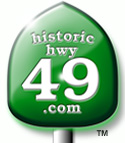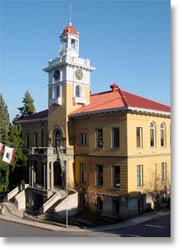|
                   
|

Gold
was first discovered along the Stanislaus River in Tuolumne County
in May of 1848 by a group of Native Americans working for Charles
M. Weber. Two months later Rev. James Woods discovered gold in
Wood's Creek in an area near what is now Jamestown, and the rush
was on.
Tuolumne is a Mi-Wuk Native
American name. The Mi-Wuk's prospered in the area
that is now Sonora until 1849 when thousands of
miners from all over the world stricken with Gold
Fever displaced them. Miners were camped all along
streams and gulches and one of the largest of the
camps, the Sonoran Camp, became the city of Sonora
in 1848 (incorporated in 1851). In 1850 the
Tuolumne region became one of the original 27
counties with Sonora as the county seat.
 The
search for gold, dissipating after its original rush, enjoyed
a rebirth in the area with the advent of hard rock and hydraulic
mining in the later part of the 1800's. Hard rock mining spawned
the birth of the lumber industry and then the railroads by 1897.
By the early 1900's Sonora and surrounding Tuolumne County added
agriculture and ranching to their industrial economics. Today
Tuolumne County, Gateway to Yosemite National Park, with the draw
of Gold Rush history adds tourism to its economic portfolio. The
search for gold, dissipating after its original rush, enjoyed
a rebirth in the area with the advent of hard rock and hydraulic
mining in the later part of the 1800's. Hard rock mining spawned
the birth of the lumber industry and then the railroads by 1897.
By the early 1900's Sonora and surrounding Tuolumne County added
agriculture and ranching to their industrial economics. Today
Tuolumne County, Gateway to Yosemite National Park, with the draw
of Gold Rush history adds tourism to its economic portfolio.
Sonora and Tuolumne County's rich
history can be seen in every corner of the county, but is best
viewed at the Columbia State Historic Park, known as the best
preserved Gold Rush town in California, and Railtown 1897 State
Historic Park that features the trains that ran supplies and lumber
in the early days of the Gold Rush. Other notable sites and buildings
you should visit are: The St. James Episcopal Church (better known
as the "Red Church, shown at the top of this page"),
the historic county jail
that now houses the county museum and history center, the county
courthouse built in 1898, the Sonora Dome, once the school and
Washington Street where many buildings and even some businesses
date back to the Gold Rush era.
 Tuolumne
County is the perfect area to view over 700 miles of streams,
abundant wildlife, and a plethora of fauna including, forests
of Giant Sequoia, oak trees, lupine, Tuolumne lilies, California
holly, manzanita, poppies, dogwood and much, much more. The County
covers 2,229 square miles with three mountains towering over the
foothills, all above 12,000 feet including Mt. Lyell at 13,090
feet. Tuolumne
County is the perfect area to view over 700 miles of streams,
abundant wildlife, and a plethora of fauna including, forests
of Giant Sequoia, oak trees, lupine, Tuolumne lilies, California
holly, manzanita, poppies, dogwood and much, much more. The County
covers 2,229 square miles with three mountains towering over the
foothills, all above 12,000 feet including Mt. Lyell at 13,090
feet.
Sonora and its surrounding
historical towns offer a variety of historical
sites, museums, fine dining, unique shops, antique
shops, bed and breakfasts, motels and hotels, RV
parks, camping, everything you will need to
compliment your visit to the Gold Country.
|
Points of Interest
| •
|
Tuolumne
County Museum and History Center |
| • |
Columbia
State Historic Park and Museum |
| • |
Railtown
1897 State Historic Park |
| • |
Yosemite
National Park |
| • |
Tuolumne
City Memorial Museum
|
| • |
Groveland
Museum/Library |
| • |
New
Melones Visitors Center and Museum |
| • |
Veterans
Memorial Hall and Military Museum |
| • |
The
Union Democrat |
|
Things to Do
Fishing, Hiking, Biking, Columbia State Historic Park, Railtown 1897 State Historic Park, Yosemite, Whitewater Rafting, Camping, Boating, Shopping, Fine Dining, Gold Panning, Museums, Golfing, Wineries, Parks, Antiques, Water Skiing, Downhill Skiing, Snowmobiling, Cross Country Skiing, Snowshoeing, OHV, Caverns, Live Theatre, Art Galleries
|
|
Newspaper
|
Union
Democrat
|
209-532-7151
|
Radio
Station
|
KKBN-93.5
FM |
209-533-1450 |
|
KVML 1450 FM |
209-533-1450 |
| KZSQ 92.7 FM |
209-533-1450 |
Transportation
Airports
|
Columbia Airport
|
209-532-4103
|
|
Pine Mountain Lake Airport
|
209-533-5685
|
Railway
|
Santa Fe Railway
|
800-825-1654
|
|
Southern Pacific
|
800-822-9601
|
|
Amtrak
|
800-872-7245
|
Bus
Local Transportation
|
Tuolumne County Transit
|
209-532-0404
|
|
Dial-A-Ride
|
209-532-0404
|
Highway Conditions
|
Caltrans
|
800-427-7623
|
|
California Highway Patrol
|
209-754-3541
|
|
AAA-California State
Automobile Association
|
800-222-4357
|
|
Facts
& Stats
|
Population:
|
4,220
|
|
Elevation:
|
1,826 ft.
|
|
County:
|
Tuolumne
County
|
|
Climate:
|
Winter: 44 degrees
Summer: 78 degrees
Rainfall: 30 inches annually
Snowfall: 0
|

|
|
|




 The
search for gold, dissipating after its original rush, enjoyed
a rebirth in the area with the advent of hard rock and hydraulic
mining in the later part of the 1800's. Hard rock mining spawned
the birth of the lumber industry and then the railroads by 1897.
By the early 1900's Sonora and surrounding Tuolumne County added
agriculture and ranching to their industrial economics. Today
Tuolumne County, Gateway to Yosemite National Park, with the draw
of Gold Rush history adds tourism to its economic portfolio.
The
search for gold, dissipating after its original rush, enjoyed
a rebirth in the area with the advent of hard rock and hydraulic
mining in the later part of the 1800's. Hard rock mining spawned
the birth of the lumber industry and then the railroads by 1897.
By the early 1900's Sonora and surrounding Tuolumne County added
agriculture and ranching to their industrial economics. Today
Tuolumne County, Gateway to Yosemite National Park, with the draw
of Gold Rush history adds tourism to its economic portfolio. Tuolumne
County is the perfect area to view over 700 miles of streams,
abundant wildlife, and a plethora of fauna including, forests
of Giant Sequoia, oak trees, lupine, Tuolumne lilies, California
holly, manzanita, poppies, dogwood and much, much more. The County
covers 2,229 square miles with three mountains towering over the
foothills, all above 12,000 feet including Mt. Lyell at 13,090
feet.
Tuolumne
County is the perfect area to view over 700 miles of streams,
abundant wildlife, and a plethora of fauna including, forests
of Giant Sequoia, oak trees, lupine, Tuolumne lilies, California
holly, manzanita, poppies, dogwood and much, much more. The County
covers 2,229 square miles with three mountains towering over the
foothills, all above 12,000 feet including Mt. Lyell at 13,090
feet.